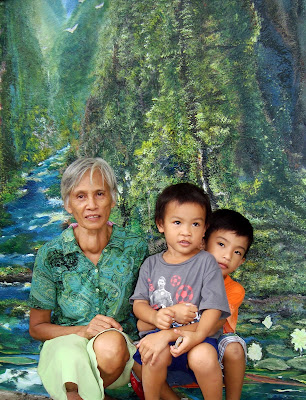Dr Abe V Rotor
Living with Nature School on Blog
Paaralang Bayan sa Himpapawid (People's School-on-Air) with Ms Melly C Tenorio
738 DZRB AM Band, 8 to 9 evening class Monday to Friday (www.pbs.gov.ph)

Flash flood as I recall it in painting, acrylic 2009
The water kept on rising and dad made another notch on the post of our stair.
It is the season of siyamsiyam we call in Ilocano nepnep, the phenomenal – or is it proverbial? – “nine-plus-nine days of continuous rainfall” which occurs usually in August, the rainiest month in the country and peak of the monsoon in the Asian region. But it had been raining much longer than that, and dad said it would last for forty days, citing the story in the bible about Noah’s Flood.
I was in the elementary but I was then strong enough to wade and retrieve our empty basi jars or burnay being swept away by the flood. Since there was no dry ground left I pulled the jars from the rushing current. It was not easy to restrain a jar partly filled with water so that you have to empty it as much as you can before you could pull it to safety. Dad and I barely understood each other at the top of our voices in the downpour and rumbling flood, but I knew he was telling me to let the jars go because of the extreme danger, pointing at the main current just across the house.
But I simply ignored him not realizing the danger until he pulled me, letting off the jars to roll in the current sometimes banging at one another. We never gave up though with whatever we could under the extreme situation. My brother Eugene was even more daring, overtaking the jars before they were swept to the street. Manang Veny kept an watchful eye on the jars in the cellar and under the sagumbi (kichen-granary).
When we were nearly exhausted dad examined the water level he marked earlier. It was down two marks which meant the water was receding. Only then did we realize we had been working in danger, cold and hungry, for the whole morning. In the afternoon the jars came to a halt in the muddy sediment. The flood was over. I thought I saw a white dove flying above.
Where did the floodwater come from? Towards the east is the edge of the Cordillera range running parallel with the coast ofSouth China Sea . Dad used to tell me that when he was like me then, it was verdant green, bluish in the morning mist and before dusk.
I was in the elementary but I was then strong enough to wade and retrieve our empty basi jars or burnay being swept away by the flood. Since there was no dry ground left I pulled the jars from the rushing current. It was not easy to restrain a jar partly filled with water so that you have to empty it as much as you can before you could pull it to safety. Dad and I barely understood each other at the top of our voices in the downpour and rumbling flood, but I knew he was telling me to let the jars go because of the extreme danger, pointing at the main current just across the house.
But I simply ignored him not realizing the danger until he pulled me, letting off the jars to roll in the current sometimes banging at one another. We never gave up though with whatever we could under the extreme situation. My brother Eugene was even more daring, overtaking the jars before they were swept to the street. Manang Veny kept an watchful eye on the jars in the cellar and under the sagumbi (kichen-granary).
When we were nearly exhausted dad examined the water level he marked earlier. It was down two marks which meant the water was receding. Only then did we realize we had been working in danger, cold and hungry, for the whole morning. In the afternoon the jars came to a halt in the muddy sediment. The flood was over. I thought I saw a white dove flying above.
Where did the floodwater come from? Towards the east is the edge of the Cordillera range running parallel with the coast of
I realized how different it was on that day the floodwater came down. It is worse today. When the day is clear you can see the scars of erosion in roan and orange and ochre, breaking the monotony and giving it a somewhat romantic touch. But these are not good signs. In fact they are signs of destruction of the forest cover, the watershed of the narrow strip of flat land spreading out northward and spilling westward to the South China Sea . Along it is a chain of villages around towns wedged by the mountain and the sea. One can imagine the movement of water when it rains, and how ground water is trapped and stored to irrigate tobacco, vegetables and other summer crops.
But without trees, runoff water simply rushes down into flood, scouring on its way riverbanks, farms and houses. There is not enough time and foothold for rain to seep into the ground and feed the spring and aquifers. And there is not enough ground water to be drawn out from wells. Because water is scarce and too deep trees succumb in summer and brushfire often sweeps and consumes the dying vegetation.
Many years has passed since the Noah’s Flood of my childhood. I trained my tired aging eyes over the Cordillera of my childhood. It too, is now old, tired and worn.~
Many years has passed since the Noah’s Flood of my childhood. I trained my tired aging eyes over the Cordillera of my childhood. It too, is now old, tired and worn.~

























































